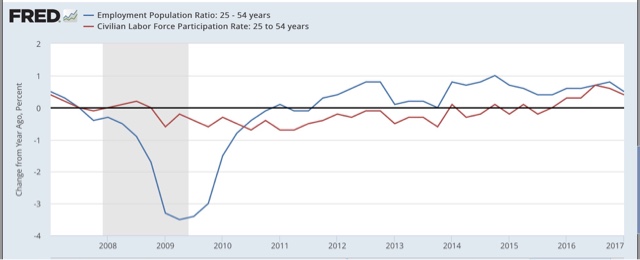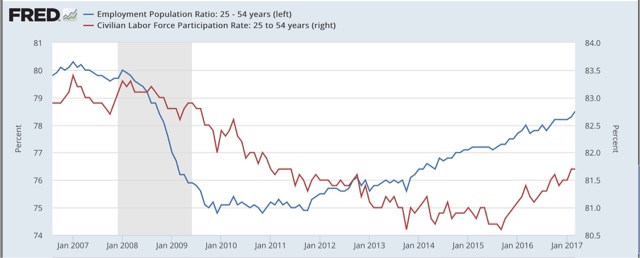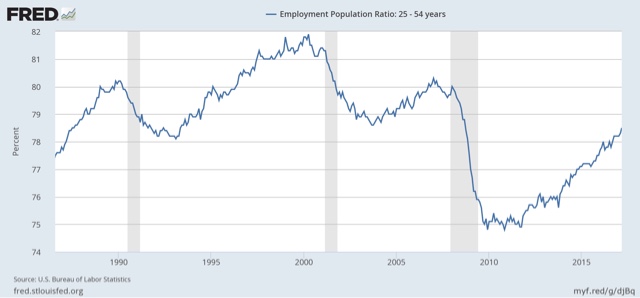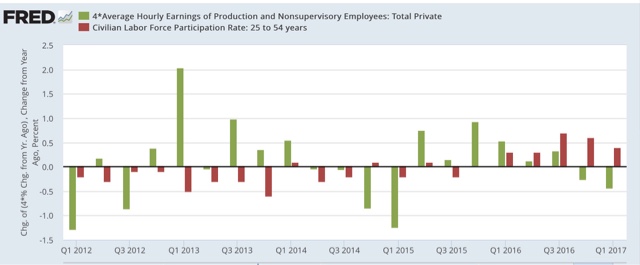By New Deal democrat Prime working age employment up, participation up (finally) – now how about wages? The March jobs report finishes the first quarter, which make it easier to update some labor participation trends, which, along with wages, has really lagged in this nearly 8 year old expansion. In order to eliminate the issue of the huge Baby Boom generation retiring, and to a lesser extent college and graduate students, we have some good data on the prime age 25-54 demographic. Historically, labor participation continues to decline after a recession ends, and picks up after the employment to population ratio does. Put another way, people come off the sidelines and enter the workforces once the unemployment rate declines significantly. Here’s the long term trend, comparing the YoY% change in each: Now let’s zoom in on this expansion: Here’s the actual percentages: As you can see, the employment-population ratio for prime age workers bottomed in 2010-11 while participation continued to decline until 2015! Meanwhile the YoY change in the prime age employment to population ratio, shown in the first graph above, bottomed out near the end of the recession in 2009, while the labor force participation rate continued to decline until early 2011, almost 2 years later.
Topics:
Dan Crawford considers the following as important: Taxes/regulation, US/Global Economics
This could be interesting, too:
Joel Eissenberg writes How Tesla makes money
Angry Bear writes True pricing: effects on competition
Angry Bear writes The paradox of economic competition
Angry Bear writes USMAC Exempts Certain Items Coming out of Mexico and Canada
by New Deal democrat
Prime working age employment up, participation up (finally) – now how about wages?
The March jobs report finishes the first quarter, which make it easier to update some labor participation trends, which, along with wages, has really lagged in this nearly 8 year old expansion.
In order to eliminate the issue of the huge Baby Boom generation retiring, and to a lesser extent college and graduate students, we have some good data on the prime age 25-54 demographic.
Historically, labor participation continues to decline after a recession ends, and picks up after the employment to population ratio does. Put another way, people come off the sidelines and enter the workforces once the unemployment rate declines significantly. Here’s the long term trend, comparing the YoY% change in each:
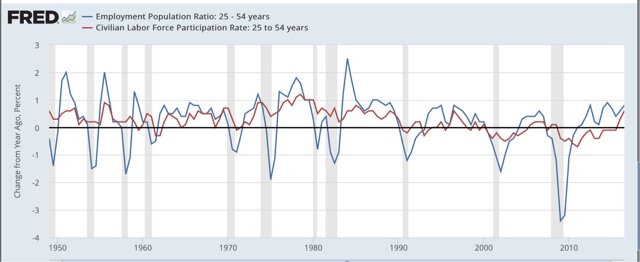 Now let’s zoom in on this expansion:
Now let’s zoom in on this expansion:
Here’s the actual percentages:
As you can see, the employment-population ratio for prime age workers bottomed in 2010-11 while participation continued to decline until 2015! Meanwhile the YoY change in the prime age employment to population ratio, shown in the first graph above, bottomed out near the end of the recession in 2009, while the labor force participation rate continued to decline until early 2011, almost 2 years later.
While participation has picked up a lot, it remains about 2% below its 2006 peak, and more than 3% below its 1999 peak:
It is disconcerting that so long after the end of the Great Recession, participation is still lagging.
But if participation has been lagging (but finally improving) wages have lagged even more.
Let me start with a reminder that there appears to be a complex interaction between participation and wages. In general, wages pick up a little after participation. BUT, if participation increases unusually rapidly, it will tend to drive down wage growth, as it did in the later 1970s and 1980s:
We have had a more rapid increase in participation in the last two years than at any time since 1989 with the exception of 1996 (red in the graph below), and that has tended to keep wage growth depressed:
It’s counter-intuitive, but the history of the last half century suggests that wage growth will pick up as this increase gets absorbed. We’ll see whether, at long last, labor finally gets a significant share of the increased wealth during this expansion.

